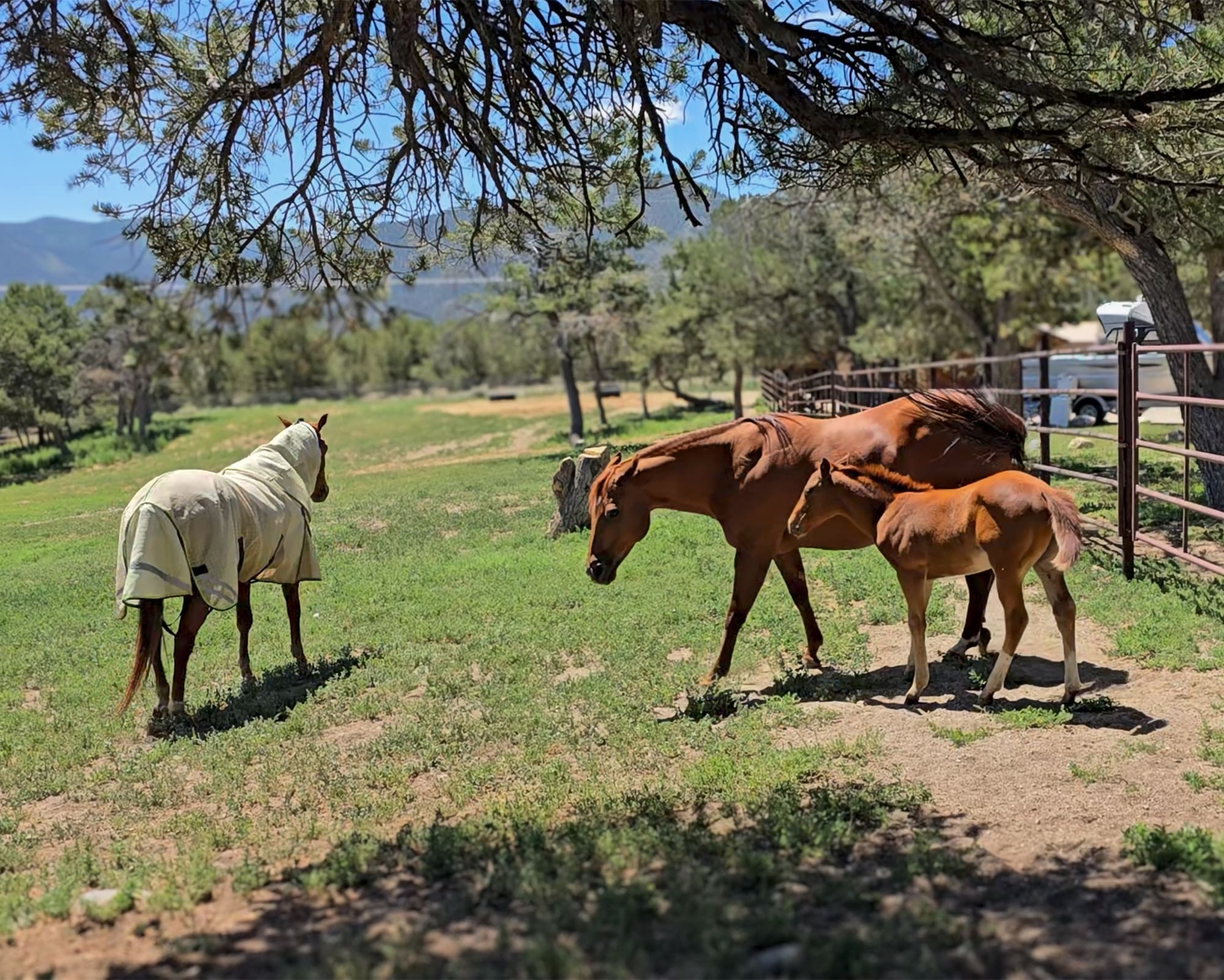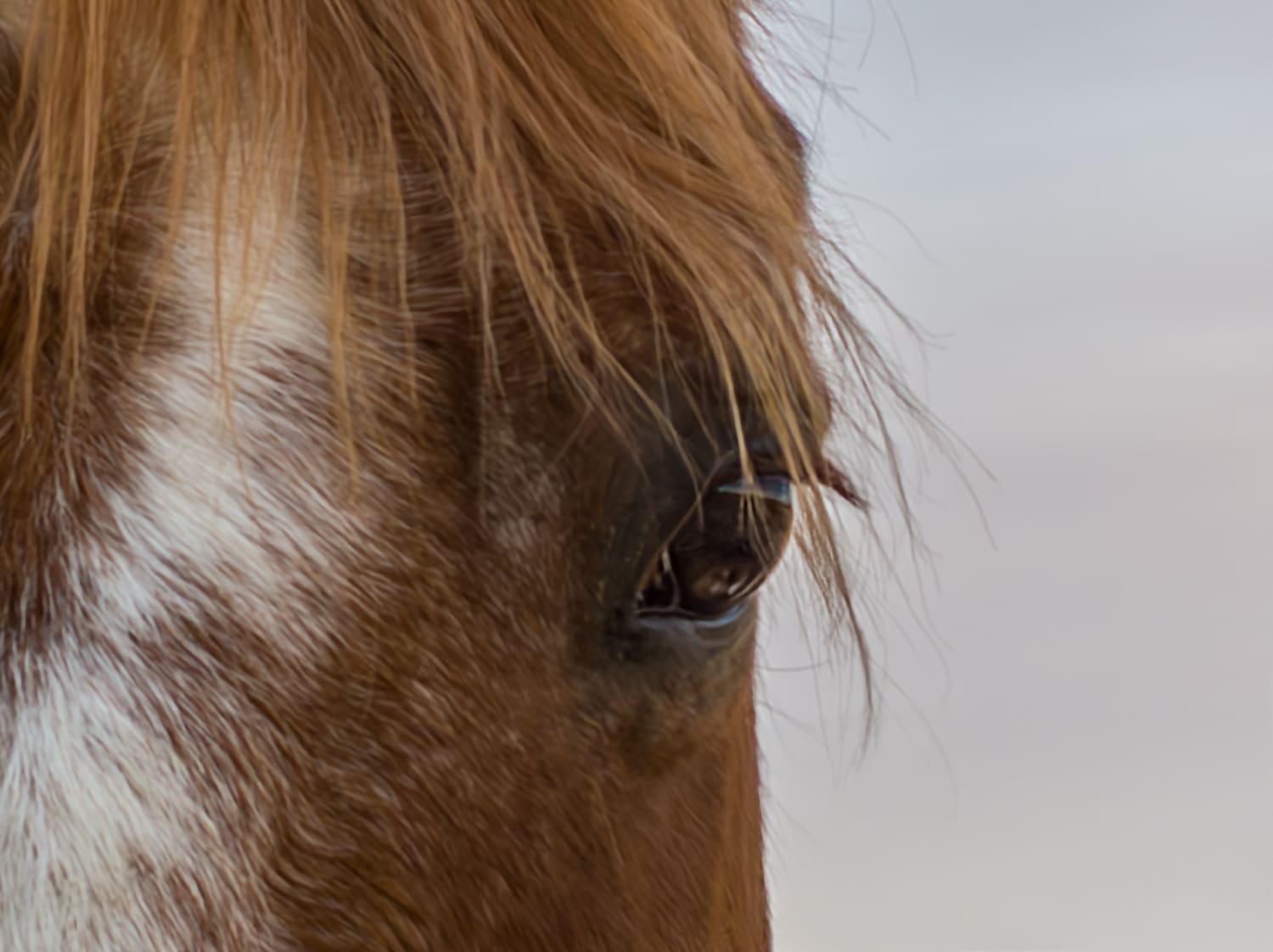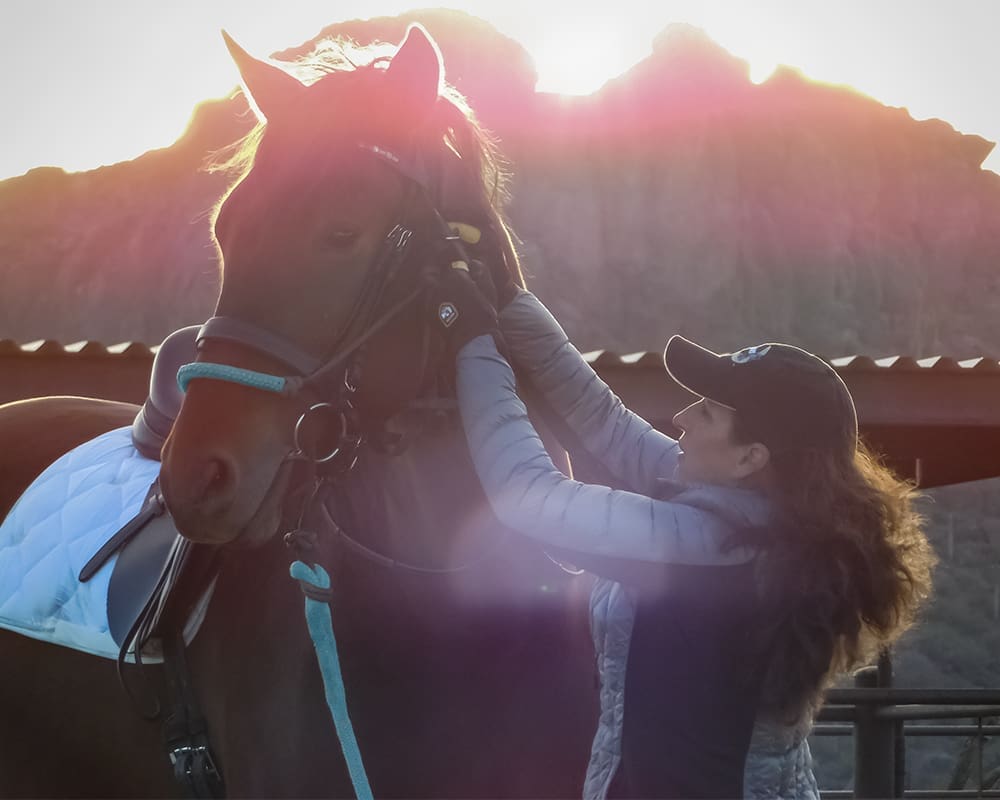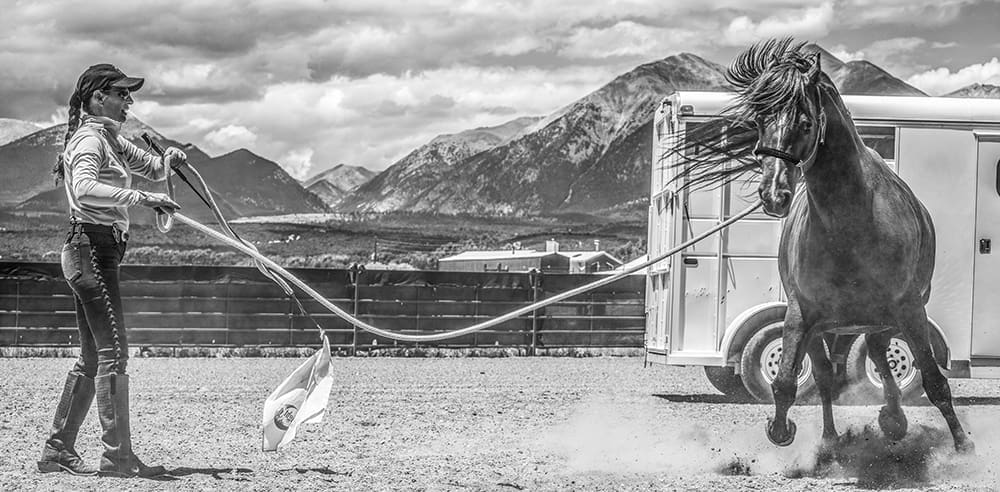Does your trail horse paw, walk off when you mount up, or go at an inconsistent speed? Correct these behavioral woes with these techniques from top trainer/clinician Julie Goodnight.
BY JULIE GOODNIGHT WITH HEIDI MELOCCO
Horses behave in the way they’re most motivated to act at the moment. Sometimes, what we might call “bad” behavior is simply what your horse has been trained to do — or what he’s been allowed to get away with.
If your horse thinks he’s in charge or that there’s no penalty for behaving badly, his behavior may turn from annoying to dangerous.
When I’m trail riding, I want to relax and take in the scenery. I want a horse that’s calm in his new environment and isn’t pawing as we get going or taking off too soon when I saddle up.
I also want a horse that goes at the speed I choose. I may want to relax and ride slowly, or pick up speed and have a little fun when the terrain allows.
You have to be a strong leader for your horse to act as your partner, and follow your lead and expectations. You have to teach him what you expect and be consistent with your rules so he knows how you expect him to act on and off the trail.
When your horse knows you’re the leader, you won’t have to micromanage him on the trail. You’ll gain confidence, knowing he’ll be a patient, willing trail partner.
Here, I’ll explain my three top pet peeves when it comes to trail-horse behavior. I’ll tell you what caused the behavior, why it’s annoying, and how to avoid or fix the behavior so that it doesn’t detract from your riding enjoyment.
Before You Begin
Don an ASTM-approved, SEI-certified riding helmet. Practice these skills at home, on a flat area with good footing. Set up productive training scenarios geared toward success on the trail. When you’re ready to test your horse’s skills on the trail, go alone, without riding buddies, so you can concentrate on reinforcing good behavior.
Behavior Bummer #1: Impatient Pawing
What caused it: Pawing is a gesture that horses use to communicate that they’re frustrated and wish they were moving. Many horses get frustrated when they’re asked to do something that they don’t want to do. Your trail horse might paw when you hold him back from moving on with a big group of horses. He wants to get moving and stay with the herd. He might also paw when he’s bored, and you’re not paying attention to him, such as when he’s tied inside or to your trailer, or during a riding break.
Why it’s annoying: If your trail horse is highlined, his pawing can harm the terrain. Inside the trailer, pawing is loud and distracting. He can injure himself if he’s allowed to continue and throw a fit.
How to avoid/fix the behavior: Using the technique I describe below, teach your horse to stand tied without showing any signs of frustration or impatience. Teach him to stand quietly as you groom him, tie him to a post, and during your designated training time.
Your horse will soon learn that there’s no sense in getting frustrated or showing impatience — pawing doesn’t lead to a release or a reward. He’ll learn not to waste energy if pawing has no reward.
To teach your horse to stand tied, start teaching him to ground-tie every time you work with him. Outfit him with a rope halter and 15-foot training lead. Holding the lead in one hand, turn and face him. Give a verbal cue to “whoa.” If he stands quietly, lay down the middle of the rope. (Maintain your hold on the end of the rope if you must correct your horse often.)
If your horse moves a hoof or turns his head too far to the side, correct him by moving the rope in a snapping motion toward the halter, and return him back where he started.
When your horse knows he must stand still, lay the rope on the ground to test him even more. (Note that this process takes time to develop.)
When your horse understands that you have authority and that he must follow your voice command, the cue to stand still can carry over to any time he’s tied. Tie him, tell him “whoa,” and walk away. If he paws, avoid approaching him to give him any kind of attention. You must expect him to do what he knows how to do — stand still.
If your horse paws often, make sure he spends time tied at home in a safe environment before expecting the behavior to diminish on the trail. He should stand tied for up to an hour (making sure he’s in the shade and has access to water and before and after).
During the time your horse is tied, leave him alone; don’t approach him if he paws. Attention of any kind would reward him for the behavior. If you run back to your pawing horse, and give him attention, he’ll think his pawing caused you to come back.
If your older horse has an ingrained pawing problem while standing tied, ask a professional trainer to help you train your horse to stop pawing by using soft, rebraided cotton hobbles. Use caution, and make sure your horse is monitored by someone who’s done the process many times.
Note: If you’re under saddle and your horse begins to paw, you mustn’t hold him still. He’s having an emotional meltdown and won’t be able to keep his feet still. Instead, move him in turns from right to left to keep him moving but focused on you. When he seems calmer, ask him to stand again. If he doesn’t stand still, turn him to the right and left again — making it a challenge not to listen and easy to stand still and be patient.
Behavior Bummer #2: Walking Off as You Mount Up
What caused it: A horse should learn from the very first time that he’s ridden that mounting doesn’t mean “go.” Most horses that walk off without a cue either never learned the skill as a colt or have been untrained by the rider.
This movement without a cue annoys me, because I want the horse to see me as the leader. If he steps off without a cue, he thinks he’s in charge from the first step of our ride. I don’t want that first interaction to be one of disrespect and disobedience.
Horses constantly look for patterns in your cueing and, if allowed, may come to their own conclusions about what they should do next. If you never require your horse to stand still when you mount up, he’ll quickly learn a new pattern — a person sitting in the saddle means “go.”
Why it’s annoying: Your horse soon learns to step forward as soon as you sit down or put your foot in the stirrup. The trend worsens until you have trouble stepping into the stirrup without your horse walking off.
How to avoid/fix the behavior: This problem is easy to prevent. Don’t allow your horse to step forward at all until you actively give a cue to step forward.
If your once-well-trained horse suddenly decides that he should step off without a cue, go back to ground work, and ask him to stand perfectly still with a rope halter and long training lead (similar to the ground-tying lesson described earlier).
Ask your horse to stand still by pointing your toes toward his shoulder and giving a verbal cue to “whoa.” Then correct him every time he takes a step or moves his nose to the side. Wave the lead rope toward the halter as a correction.
When your horse will stand still on command with a halter and lead, saddle up, and place his bridle under the rope halter with the lead attached. (Never correct your horse by pulling on the bit or bridle reins — the pressure from the halter and lead is enough and prevents you from harming his mouth.)
Keep your expectation that your horse will stand still as you start to mount up. Mount slowly, with the lead line in hand. Watch for the moment he begins to move. If he takes a step, step down, and correct him, requiring him to stand still.
If you get so far as to sit in the saddle, your correction switches to controlling your horse with the reins. Keep your reins short enough so that you can control him immediately if he takes a step. If he does take a step, sit back and pull back on the reins, and require him to stand still.
If your horse is agitated and anxious, and continues to move his feet, put him to work. Circle to the left; circle to the right; circle again to the left. Then allow him to stop and take a break. Reward him if he stands still. If he wants to walk off again, repeat the circling exercise. Show him that standing still is what you asked for and is the easiest option.
Sometimes a horse that won’t stand still may be uncomfortable because of the rider’s static weight (horses are built for strength while moving, not while standing still) or because his saddle doesn’t fit. He may shift from side-to-side and fidget. You might get the impression that he’s attempting to stand still, as he’s otherwise not showing impatience or seeming to want to do something different.
If your horse fidgets from side-to-side rather than walking forward when you ask him to stand, consider checking saddle fit and consulting a veterinary chiropractor.
Behavior Bummer #3: Going Too Slow or Too Fast
What caused it: You’re not in control of your horse’s speed, and therefore, not in control of your horse. In the saddle, there are two things you should control — speed and direction. If you don’t control how slowly or quickly your horse moves, you aren’t the one in charge. If he hasn’t been trained to follow cues to go at the speed you
dictate, you need to train him now.
Why it’s annoying: Riding a trail horse that only moves slowly or takes off at full speed (with no middle gears) is annoying for you and for anyone riding with you. Other horses have to work to keep up so the group can stay together. A horse acting badly can get the whole group amped up to go at a fast speed that no one really wants. If you’re dealing with a speed demon, you might feel frantic and out of control.
How to avoid/fix the behavior: If your horse ignores your speed cues — and takes off at a pace that you don’t want — first make sure you know how to perform the emergency-stop cues. (To learn how to safely use a pulley rein, and perform the one-rein stop, go to TrailRiderMag.com.)
Practice a one-rein slow-down technique at home in a flat area with good footing. Turning a horse quickly with the one rein stop on the trail can cause him to lose his balance and fall. Also, not all trails have the space needed for a horse to turn. When you practice this turning technique at home, you’ll soon teach your horse that he can continue to move forward, but at a slower pace.
When your horse speeds up, pick up one rein, and pull it up and back toward your opposite shoulder. This will cause him to turn and disengage the hindquarters.
Any time your horse speeds up without a cue, slide your hand down one rein and start to pull up and back. With enough repetition, you can teach the horse that when you slide your hand down the rein, you’ll be slowing or stopping him, and he should slow down. He doesn’t have to make a full turn. He knows what’s coming next and will learn to slow his gait while moving ahead. Soon, your horse will slow down easily when you pick up slightly on one rein.
You can also check and release your horse. Pull up and back on the reins as you sit deep into the saddle, then immediately release when your horse slows. He’ll learn that you want to slow down.
Be very careful not to pull on the reins with constant pressure — that will actually teach the horse to pull against you and continue to move fast. If you don’t release at the first hint that he’s slowed, you’ll cue him to fight against you and cause a tug-of-war.



